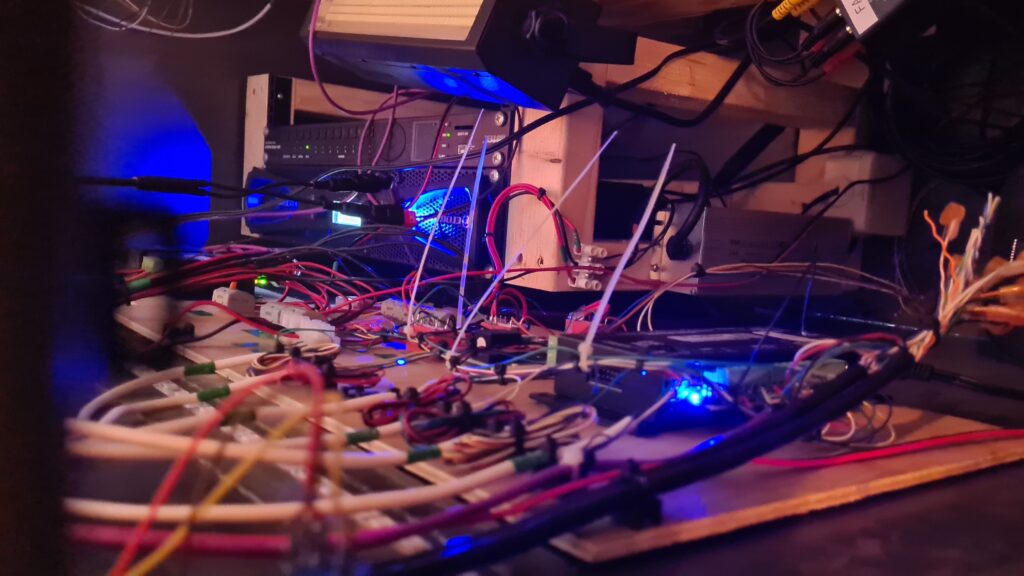
OSCHII was born out of frustration and passion. For several years we produced theatrical and immersive interactive games with patched together technologies that were time consuming, complex and didn’t always live up to our creative vision. We decided it was time to turn our hard-won lessons into a new, easy to use and integrated platform. OSCHII would let us create and help others create.
This is our story:
We began building Escape Rooms a few years ago using off the shelf tech, mostly designed for ‘fright’ experiences such as haunted houses.
In many ways they were great–designed to be installed by people with limited experience and knowledge of immersive technology. We love the idea of making this kind of tech accessible to a wide range of creators.
We spent long hours up to our eyebrows in wires and circuit boards hacking everything together
But the more we worked with them, the more time consuming, complicated and expensive using this so-called simple to use, “DIY” technology became. As the games developed, the circuitry got more complicated and, unfortunately, messier. We spent long hours up to our eyebrows in wires and circuit boards hacking everything together. In the end, it just wasn’t powerful enough, it didn’t quite do what we wanted it to do, and the many hundreds of additional hours spent making circuits that allowed us to do what we wanted to do was, well, getting silly and unaffordable.
It’s fair to say that our escape rooms are fairly technologically complex.
The game technology that we use needs to network with all sorts of other things: atmospheric lighting and audio, billowing smoke, and props such as vintage telephones or swinging lights.
Because we specialise in immersive theatre, we know how to use the whole environment to affect emotion and enhance the journey of the participants. The game technology that we use needs to network with all sorts of other things: atmospheric lighting and audio, billowing smoke, and props such as vintage telephones or swinging lights. As participants move through this adventure, we also need to be able to lock and unlock game elements as one challenge ends and another begins.
We experimented with slightly different technology for our second escape room, bringing it closer to the comfort of our work in immersive theatre and allowing us to inject more drama into the experience.

Sound, light, and atmospherics were all carefully scripted and programmed into a complete timeline. In our theatrical productions, we use software that automates many functions within a show to create a slick, fully immersive experience that injects suspense and can leave people with goosebumps.
Yet we still faced the same difficulties integrating this software with the off-the-shelf games hardware. We really needed a technology that was built with all of this in mind.
Outside of work with escape rooms, we encountered similar problems.
We’ve made several large-scale interactive games for festivals, such as a challenge in which around 50 participants joining hands trigger a light show that demonstrates how working together can initiate change. Another game is the terrifying immersive adventure in which the participant becomes a fish caught by a super trawler.
We wanted to use our experiences in these creative industries to make a technology that can be shared with others.
Each time we create these experiences we spend more time working on the technology than focusing on improving the actual game experience itself. We wanted to make more time for creativity and artistry.
Escape Rooms, immersive theatre, interactive off-line gaming and sensory artworks all have many things in common – they are highly engaging, interactive, immersive, playable and fun activities that are part of a wider family of experiences. Their creation is also often sadly hindered by a lack of technical knowledge. Whilst creating OSCHII, we wanted to use our experiences in these creative industries to make a technology that can be shared with others. We wanted to reduce the steepness of that learning curve and the headaches that came with hacked together webs of technology. We wanted to be able to create, and allow others to create.
It was time to make life easier for us and cheaper for our clients. It was time to help other creators focus on artistry instead of technology. It was time for a new, better, DIY immersive technology.
Then came the pandemic. We had time! We bring you OSCHII.

